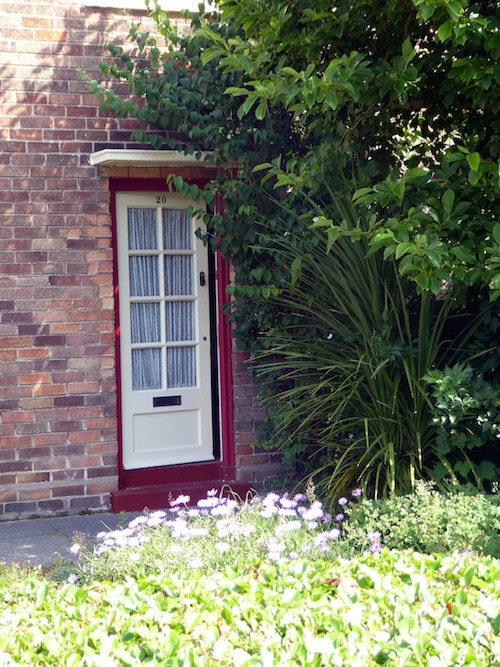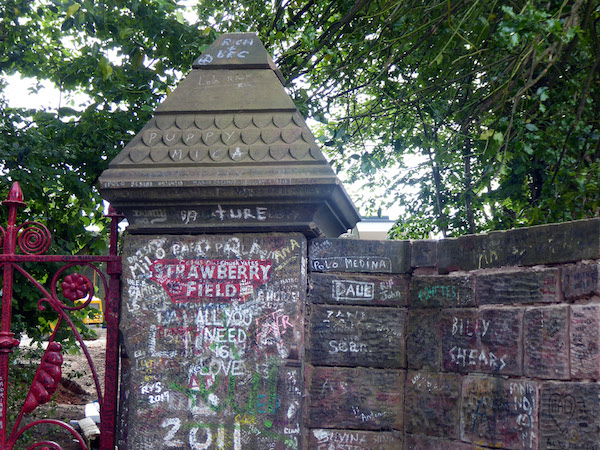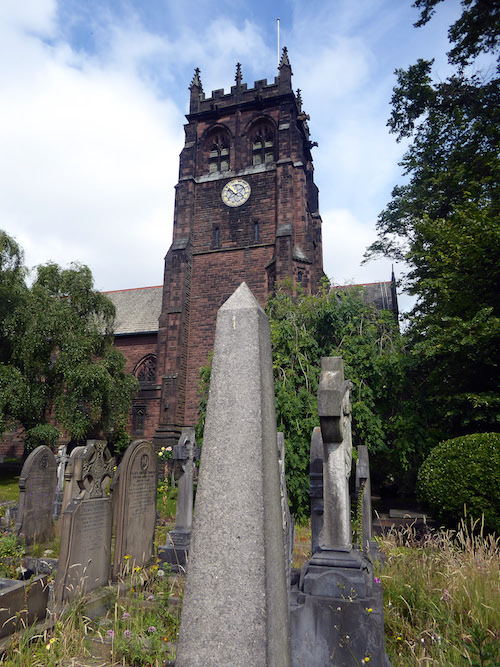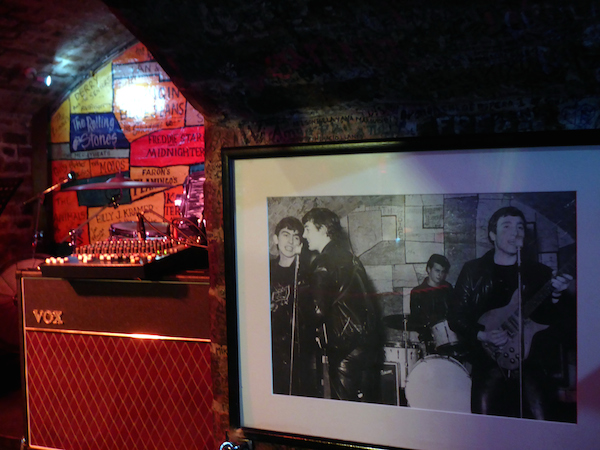The Curmudgeon: Strawberry Fields Forever
Photos by Christopher Furlong/Getty, BIPs/Getty, Geoffrey Himes
The new Danny Boyle movie, Yesterday, is a charming if lightweight picture. But before Richard Curtis’s script devolves to an all-too-predictable rom-com finish, the film does raise an interesting question: If the Beatles’ songs suddenly appeared without publicity, history or legend in today’s very different musical climate, would the public still respond to them? Would listeners embrace the music even if it arrived in inferior versions from Jack Malik, a struggling singer-songwriter from the smallest coffeehouses in Suffolk?
Yesterday offers a resounding yes to that question, and while I think the filmmakers overstate the case—after all, it took the Beatles several years of failed auditions before they gained any traction—the songs are still great in any context.
The movie posits that during a 12-second, worldwide power outage, all traces of the Beatles have vanished from stores, libraries, the internet and people’s minds. Only three people in the world remember them at all, and Jack is one of them. But as he tries to recreate the songs to perform them in public, he has no recordings or sheet music to consult, so he has to rack his brain to recall the words and chords.
To jar his memory, he decides to travel to Liverpool, the Beatles’ hometown. That’s a mind-tickling idea: that visiting the geography of where the songs were created might get us closer to the songs themselves. As it so happened, I saw the movie in the British town of Bath, and two days later I was in Liverpool on a pre-arranged trip. I decided to test the theory: Would visiting the places where John, Paul, George and Ringo grew up and first pursued music provide an insight into that music?
Fortunately, there’s a whole tourism industry in that English seaport to help one answer that question. Bus companies, taxi drivers, museums, shops and more are eager to tell you little known facts about the hometown lads, point you to the sites and to fill your luggage with Beatles T-shirts and coffee mugs. It’s hard to feel cool when you’re sitting with a crowd of tourists on a garishly painted yellow bus called the Magical Mystery Tour, but what good did “cool” ever do you? Maybe it helped you get laid when you were 17, but ever since you turned 24, it’s been an albatross around your neck. Better to get a bit closer to the music.
It’s one thing to read about England’s class system, but it’s another to see it demonstrated by the architecture of Liverpool’s neighborhoods. Richard “Ringo” Starkey, for example, was born at 9 Madryn Street, a narrow, cramped rowhouse in the tough, working-class neighborhood of Dingle. His house butted up right against the sidewalk in an area so gritty that exteriors for Peaky Blinders, the BBC TV series about 1920s criminals from the slums, are filmed a block away.
McCartney spent his teenage years at 20 Forthlin Road, also a modest brick rowhouse but slightly larger with a garden out front. Lennon spent his teenage years at his Aunt Mimi’s house at 251 Menlove Avenue, half of a duplex, with larger rooms and a larger garden. Lennon may have celebrated the “Working Class Hero,” but he had the most comfortable upbringing of the quartet.
Paul McCartney’s house (Photo by Geoffrey Himes)
John Lennon’s house (Photo by Geoffrey Himes)
The McCartney and Lennon homes are now owned by the National Trust, Britain’s cultural preservation organization, which offers limited tours inside the houses. We didn’t sign up early enough to get on a tour, but you can learn a lot just by walking around the neighborhood.
It’s a short walk, for example, from Lennon’s home to Strawberry Fields, the site of the Salvation Army’s home for orphaned and abandoned children. As a youngster, he would walk to Vale Street, climb over the rear wall and play with the boys at the home. When the Salvation Army complained to Aunt Mimi, she warned her nephew that they’d hang him if he kept trespassing. As an adult, Lennon sang, “I’m going to Strawberry Fields; nothing is real, and nothing to get hung about.”
I asked the Salvation Army guide what the organization’s current policy is about neighborhood kids climbing the wall to get in. “We’ll take it on a case-by-case basis,” she said. “But we definitely will not be hanging them.”
Lennon could identify with the orphaned kids, because his father had abandoned the family when John was three. His mother’s family decided he’d be better off with his Aunt Mimi than with his mother Julia, who was hit and killed by an automobile when her son was 17.
McCartney’s mother died from an embolism when he was 14. Ringo’s father deserted the family when the son was four. Only George Harrison grew up with both of his parents. The two dead mothers and two absconded fathers created both an instability and a longing that perhaps gave their music its rule-breaking recklessness and its emotional undertow.
The old entrance to Strawberry Fields (Photo by Geoffrey Himes)
Strawberry Fields, then, was a symbol of where you could end up if your parents disappeared. The old orphanage was torn down in 2005, and the Salvation Army is rebuilding the site with a visitors’ center for music fans and classrooms for vocational training. Paste was one of the first American publications allowed past the famous red gate and onto the site before its scheduled September opening. Etched into the glass walls of the new building are the notes from Lennon’s song, and through the windows you can see the newly planted strawberry patches.
Though the Beatles came from different tiers within the working class, they definitely felt looked down upon when they traveled from the southern suburbs into downtown Liverpool with its towering churches and well-tailored men talking in posh accents. Lennon, McCartney and Harrison all passed their exams and attended either the Liverpool College of Art or the Liverpool Institute, side-by-side high schools in the shadow of the brownstone Anglican cathedral, still in the last years of its 74-year construction. (Today both high schools have been reconfigured, with funding from McCartney, as the Liverpool Institute for Performing Arts.)
These teenagers were smart enough to be stimulated by the Lewis Carroll and Joseph Conrad books they were assigned, but also poor enough to have a chip on their shoulders when brushing up against their more privileged classmates. It was a combination that allowed them to marry the tattered-book rebellion of Allen Ginsberg to the black-leather-jacket rebellion of Elvis Presley.
The bus rides that took them back and forth between home and school often passed Penny Lane, a neighborhood named after its main thoroughfare. Paul eventually used that street to epitomize the tidy, lower-middle-class life that he both resented and fondly remembered. Today you can still see not only the famous road sign, but also the bank, the barber shop, the motor car and “the shelter in the roundabout.” On the day I was there, I could also look up and see the “blue suburban skies.”
McCartney and Harrison became friends on the bus to the Liverpool Institute, constructed like a Greek temple with four stout pillars out front. Lennon and Stuart Sutcliffe became friends at the Liverpool College of Art next door. McCartney and Lennon finally met on July 6, 1957, when a mutual friend, Ivan Vaughan, introduced them inside the auxiliary building for St. Peter’s Church in Wooten, once a rural village that had been swallowed up by the ever-expanding Liverpool.
Lennon was there to play the church’s “garden fete” behind the brownstone church with the Quarrymen, a skiffle group he had named after his nearby Quarry Bank grammar school (since renamed the Calderstones School). They played the Del-Vikings’ recent hit, “Come Go with Me,” but Lennon couldn’t remember all the words, so he made up his own. When they took a break, McCartney asked if he could get up and play a song. He got all the words and chords correct on Eddie Cochran’s “Twenty Flight Rock,” and Lennon was impressed, even a bit intimidated. A few weeks later, he nonetheless invited McCartney to join the Quarrymen.
The church and the auxiliary building across the street are still there, surrounded by well-tended gardens and a cemetery. Inside the graveyard is a tombstone that reads, “Eleanor Rigby, the beloved wife of Thomas Woods…, died 10th Oct. 1939, aged 44 years.” McCartney has denied his song “Eleanor Rigby” was inspired by the grave marker, but it seems too unlikely a coincidence to credit his demurral. And to see it on the grounds where he first met John Lennon is too delicious a convergence to dismiss.
St. Peter’s Church (Photo by Geoffrey Himes)
The Eleanor Rigby gravestone (Photo by Geoffrey Himes)
After a series of comings and goings, the Quarrymen were down to three guitarists: Lennon, McCartney and Harrison. In 1960, they convinced Stu Sutcliffe to buy a bass and play with them under a new name: the Silver Beetles. [sic] They found rehearsal space at the Jacaranda Club, not far from their school. In exchange for use of the basement, John and Stu painted murals in the stairway and bathrooms, and you can still see those paintings today, a reminder of Lennon’s roots in the visual arts. Jacaranda owner Allan Williams eventually let them play gigs at the club; he booked their first gigs in Hamburg, Germany, and became their manager.
By the time they left for Germany, the group had added a drummer named Pete Best, the son of the owner of the Casbah Café, where the Quarrymen had first honed their skills. The reconfigured band shortened and changed the spelling of its name to the Beatles. After a month and a half at the Indra Club, they moved to the Kaiserkeller, where they alternated sets with another, better known Liverpool band, Rory Storm & the Hurricanes, whose drummer was Ringo. By the beginning of 1961, they were back home and played their first of 292 gigs at the Cavern Club.
The Cavern Club still exists on Mathew Street in downtown Liverpool, though ten yards up the street and much deeper underground. Some 15,000 of the original bricks were used to recreate the venue after it collapsed under construction for a railway ventilation shaft that was never completed. That’s close enough for me.
After you walk down the four flights of stairs, you emerge into a long room flanked by brick archways on both sides with a brick, barrel-vault ceiling overhead. Additional seating is on either side of the arcade, and the stage is at the opposite end of the long room from the stairway and bar. The former wine cellar and World War II air-raid shelter opened as a trad-jazz club in 1957 but is remembered today for the Beatles’ regular shows there between 1961 and 1963.
It’s easy to imagine how exciting it must have been when Liverpool’s teenagers crowded into the narrow space for the Beatles’ lunchtime and evening shows. With girls screaming and dancing in the hot, steamy quarters as the guitar chords bounced off the brick arches, it must have been ecstatic pandemonium.
The present-day Cavern Club in Liverpool (Photo by Geoffrey Himes)
It’s still a live music venue, though today it’s more likely to be filled with families of tourists speaking in different languages. While bands play at night, when I visited in the early evening, there was a solo singer-songwriter playing Jack Malick-like covers of songs by the Beatles, Creedence and Foo Fighters. I was just glad to be there.
While the Beatles were playing the Cavern, they had replaced manager Allan Williams with Brian Epstein, who took them to London to audition for Decca Records, which turned them down, and for Parlophone Records, which signed them on the condition that they replace the drummer. Lennon and McCartney didn’t need much convincing and reached out to their friend Ringo. The girls at the Cavern were less convinced and staged a demonstration at the Cavern on Pete Best’s behalf. Harrison wound up with a black eye from the melee.
A few days later, I was at 20 Manchester Square in London, where the EMI/Parlophone headquarters had been when George Martin signed the Beatles and where the famous photos of the band hanging over the stairway railings were taken. The label is gone, and they took the iconic stairway with them.
Martin was soon working with them at Abbey Road Studios. The building had opened as the Gramophone Studio in 1931 with classical composer Edgar Elgar conducting the London Symphony Orchestra through his own compositions. It was called the EMI Recording Studios when the Beatles cut most of their music as a band there. The handsome white house that faces the street contains the studio offices; the actual recording rooms are inside the non-descript, yellow-brick building in the back.
The Beatles named their 1969 album after the studios’ address, 3 Abbey Road, and were photographed on the cover walking across the street’s crosswalk—the “zebra” in British slang. The studio was renamed in 1970, and today, music fans from around the world have themselves photographed walking the zebra—much to the annoyance of the horn-honking local drivers. Was I too cool to stoop to such a cliché as asking someone to take my picture walking the zebra? No, I was not.
Abbey Road Studios (Photo by Geoffrey Himes)
The Beatles did cut half a dozen songs, including “Hey Jude” and “I Want You (She’s So Heavy),” at the crosstown Trident Studios, which had the city’s first eight-track recorder. That studio, at 17 St Anne’s Court in Soho, was also the site of famous recordings by the Rolling Stones, David Bowie, Queen and Lou Reed. It too is still in business, but the public can’t go beyond the street signage.
In the St. John’s Wood neighborhood near Abbey Road, you can find Primrose Hill, a public park where Paul liked to walk with his beloved dog Martha and met the local self-styled prophets. That’s where he wrote the songs “Martha My Dear” and “Fool on the Hill.” He still lives at 7 Cavendish Avenue, and from the sidewalk one can see the black drain spout where an overzealous female fan climbed up and “came in through the bathroom window.”
Near Buckingham Palace was Epstein’s London townhouse. It was there on June 1, 1967, that Paul met his future wife, the photographer Linda Eastman, during the press launch of the Sgt. Pepper album. Less than three months later, the closeted Epstein died from an overdose of sleeping pills in the upstairs bedroom.
Apple Records set up its headquarters at 3 Saville Row, amidst the most expensive tailor shops in England. It was there that crackpots lined up to get funding for the most harebrained schemes, and it was there, on January 30, 1969, that the Beatles played their final public concert together on the building’s rooftop. Today the building houses Abercrombie for Kids; inside is a display of Beatles memorabilia and the original elliptical stairway.
On my last day in London, I took a tour of the Royal Albert Hall. At the end, I asked the guide, “How many holes does it take to fill the Albert Hall.” Without batting an eye, she said, “4,000.”
There are many more Beatles sites in England, but these are the most obvious. There are many companies and guides who will take you around, or you can search them out on your own. Beware, however, that English cities, especially Liverpool, are not reliable about posting street signs, and many commercial establishments don’t display address numbers.
But there’s something deeply satisfying about walking the streets that these musicians and songwriters trod. Seeing whole buildings and neighborhoods is somehow more illuminating than seeing a guitar or drum kit in a museum or a Hard Rock Café—though those can be fun too. But it’s easier to imagine another time and place when you at least nail down the “place” half of the equation.






